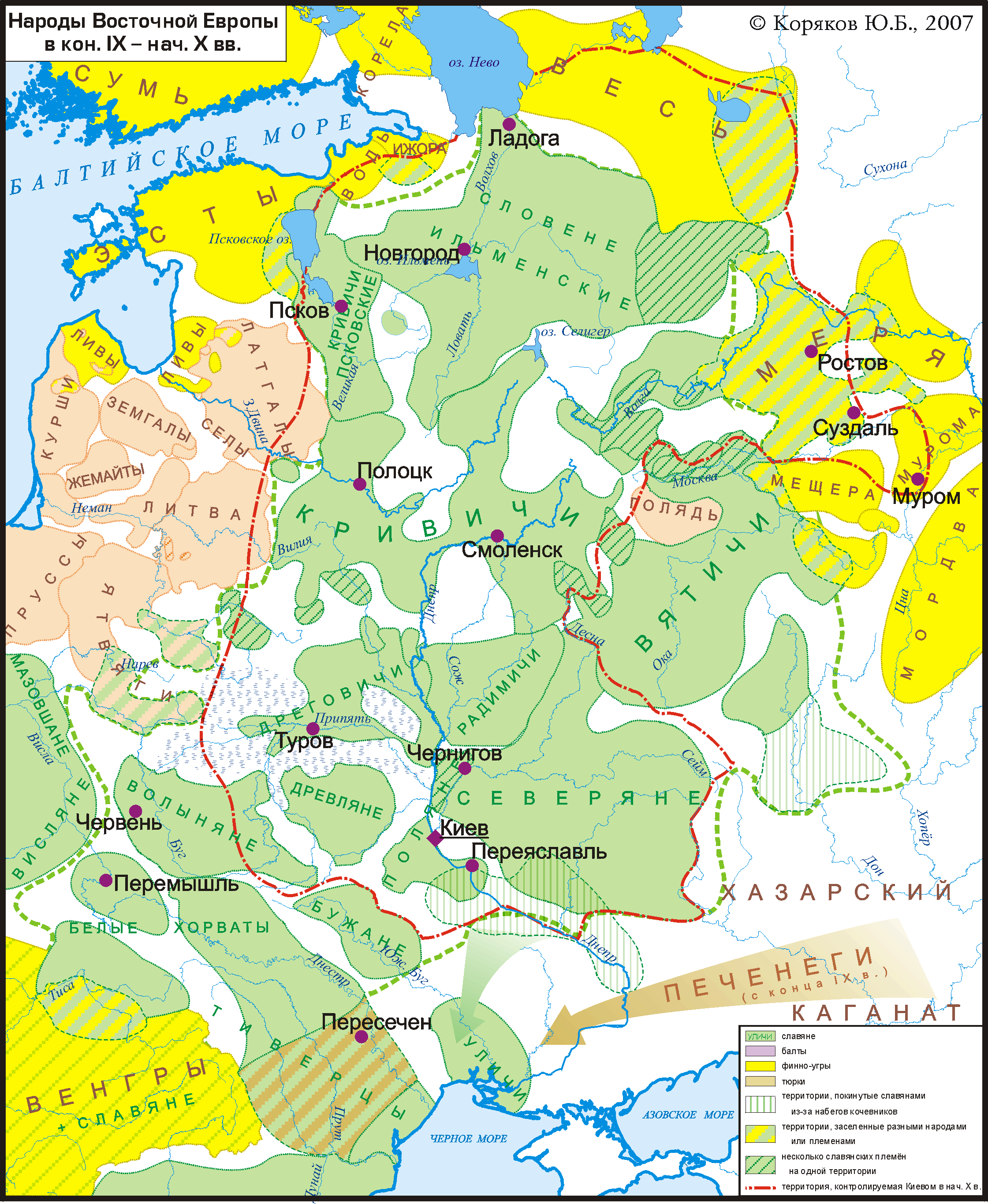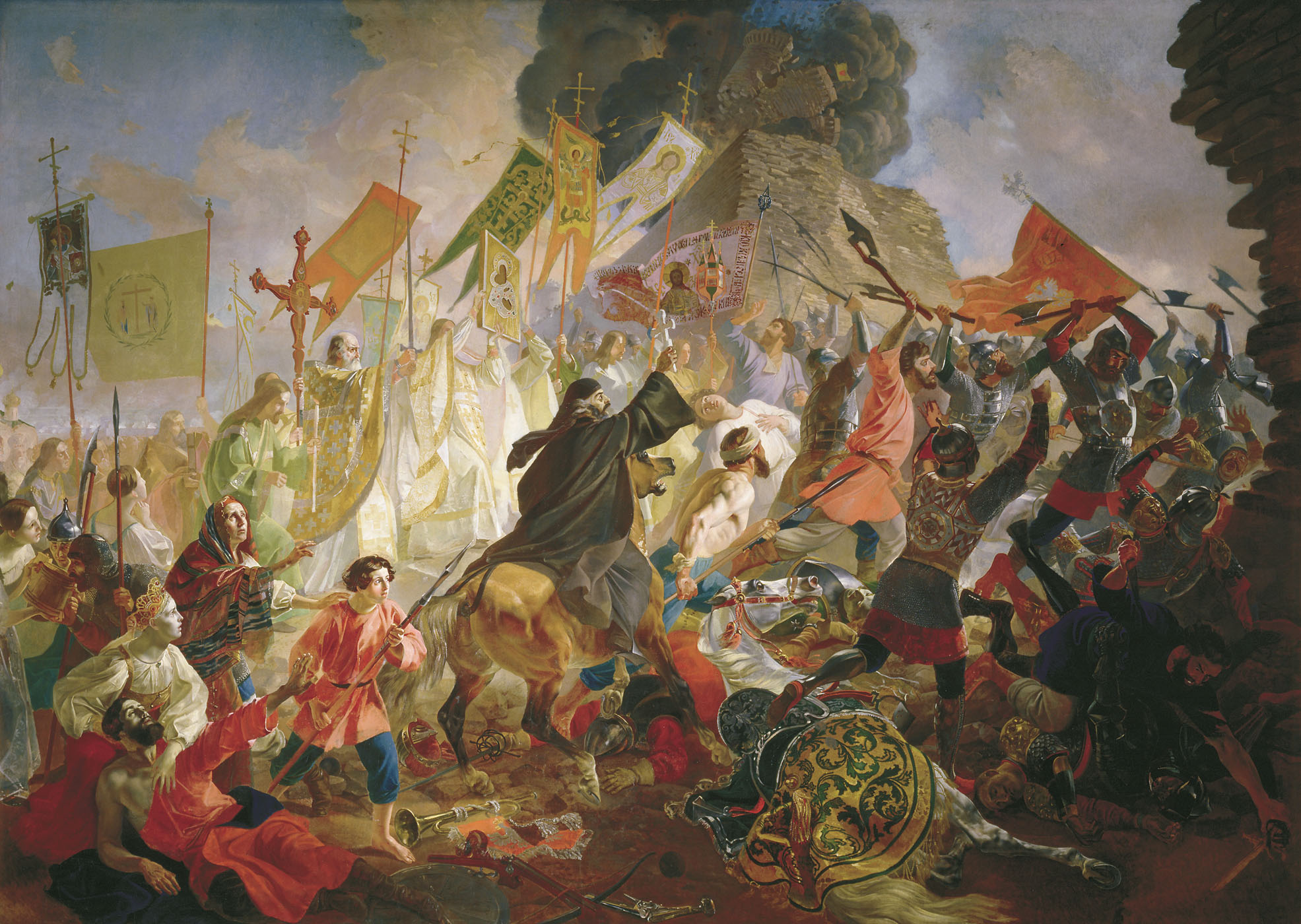|
Izborsk
Izborsk (; ; ) is a rural locality (village) in Pechorsky District of Pskov Oblast, Russia. It contains one of the most ancient and impressive fortresses of Western Russia. The village lies to the west of Pskov and just to the east of the Russian-Estonian border. History According to the '' Russian Primary Chronicle'', the town was the seat of Rurik's brother Truvor from 862 to 864. Although his burial mound is still shown to occasional tourists, archaeological excavations of long barrows abounding in the vicinity did not reveal the presence of the Varangian settlement at the site, which indicates that Izborsk was an important centre of the early Krivichs. The next mention of the town in Slavonic chronicles dates back to 1233, when the place was captured by the Livonian Brothers of the Sword. In 1330, the Pskov posadnik Sheloga constructed the Izborsk fortress on the top of Zheravya hill. In 1348, the Pskov Republic, which included Izborsk, separated from Novgorod Republ ... [...More Info...] [...Related Items...] OR: [Wikipedia] [Google] [Baidu] |
Pechorsky District
Pechorsky District () is an administrativeLaw #833-oz and municipalLaw #420-oz district (raion), one of the twenty-four in Pskov Oblast, Russia. It is located in the northwest of the oblast and borders with Pskovsky District in the northwest, Palkinsky District in the southeast, Alūksne municipality of Latvia in the southwest, and with Võru and Põlva Counties of Estonia in the northwest. Lake Peipus limits the district from the north. The area of the district is . Its administrative center is the town of Pechory. Population: 25,300 ( 2002 Census); The population of Pechory accounts for 50.6% of the district's total population. Geography Almost the whole of the district lies in the basin of Lake Peipus. The rivers in the east flow into the Velikaya River, whereas the rivers in the northwest, including the Piusa River, flow into Lake Peipus directly. Minor areas in the southwest of the district belong to the basin of the Pededze River and thus to the basin of the Daugava ... [...More Info...] [...Related Items...] OR: [Wikipedia] [Google] [Baidu] |
Truvor
Sineus and Truvor () are mentioned in Rus' chronicles as brothers of Rurik, a Varangian chieftain of the Rus' who is traditionally considered to be the founder of the Rurikids. According to legendary calling of the Varangians as recorded in the ''Primary Chronicle'' (PVL) and ''Novgorod First Chronicle'', the three brothers were invited by East Slavic and Finnic tribes to reign over them in what is now northwestern Russia in 862. Sineus established himself at Beloozero and Truvor at Izborsk. After they died, Rurik consolidated their territories into his own. Description According to the ''Primary Chronicle'', compiled in , a group of Varangian Rus' were invited to rule over the local East Slavic and Finnic tribes after they began fighting each other. Rurik, the oldest of the brothers, established himself in Novgorod, while Sineus established himself at Beloozero, on the shores of Lake Beloye, and Truvor at Izborsk, although archaeological findings have also suggested that his ... [...More Info...] [...Related Items...] OR: [Wikipedia] [Google] [Baidu] |
Pskov Republic
The Pskov Republic () was a city-state in northwestern Russia. It is traditionally considered to have won its formal independence from the Novgorod Republic in 1348. Its capital city was Pskov and its territory was roughly equivalent to modern-day Pskov Oblast. History Origins After the disintegration of Kievan Rus' in the 12th century, the city of Pskov and its dependent territory became part of the Novgorod Republic, but it continued to enjoy self-government under the supervision of a ''posadnik'', or chief executive, that was appointed by Novgorod. Pskov had the status of a borough (), but was given the unique right to have boroughs of its own, with Izborsk being the most ancient among them. The first period of self-declared independence lasted from 1228 to 1242, ending when the city was temporarily annexed by the Livonian Order. After being liberated by Aleksandr Nevsky, the city pledged its fealty to the grand prince and Novgorod. Due to Pskov's leading role in the strug ... [...More Info...] [...Related Items...] OR: [Wikipedia] [Google] [Baidu] |
Estonia–Russia Border
The Estonia–Russia border is the international border between the Republic of Estonia (European Union, EU and NATO member) and the Russian Federation (Commonwealth of Independent States, CIS and Collective Security Treaty Organization, CSTO member). The border is long. It emerged during World War I, in 1918, as Estonia Estonian Declaration of Independence, declared its independence from the then warring Russian Empire, Russian and German Empire, German Empires. The border goes mostly along the national, administrative and ethnic boundaries that have gradually formed since the 13th century. The exact location of the border was a subject of Estonia–Russia relations, Estonian–Russian dispute that was resolved with the signing of the Border Agreement, but neither Russia nor Estonia have completed its ratification yet. It is an external border of the European Union. In September 2022, Estonia closed its borders to most Russian citizens in response to the February 2022 Russia ... [...More Info...] [...Related Items...] OR: [Wikipedia] [Google] [Baidu] |
Novgorod Republic
The Novgorod Republic () was a medieval state that existed from the 12th to 15th centuries in northern Russia, stretching from the Gulf of Finland in the west to the northern Ural Mountains in the east. Its capital was the city of Novgorod. The republic prospered as the easternmost trading post of the Hanseatic League, and its people were much influenced by the culture of the Byzantines, with the Novgorod school of icon painting producing many fine works. Novgorod won its independence in 1136 after the Novgorodians deposed their prince and the Novgorod ''veche'' began to elect and dismiss princes at its own will. The ''veche'' also elected the '' posadnik'', who was the chief executive of the city, and the archbishop of Novgorod, subject to approval by the Russian metropolitan. The '' tysyatsky'' was also elected by the ''veche'', who was originally the military commander, and served the interests of the common people. Novgorodian nobles known as boyars dominated the ''vech ... [...More Info...] [...Related Items...] OR: [Wikipedia] [Google] [Baidu] |
Oprichnik
The oprichnina (, ; ) was a state policy implemented by Tsar Ivan the Terrible in Tsardom of Russia, Russia between 1565 and 1572. The policy included mass Political repression, repression of the boyars (Russian aristocrats), including public executions and confiscation of their land and property. In this context the term can also refer to: *The notorious organization of six thousand Oprichniki, the first political police in the history of Russia. *The portion of Russia, ruled directly by Ivan the Terrible, where his Oprichniki operated. *The corresponding period of Russian history. The term ''oprichnina'', which Ivan coined for this policy, derives from the Russian word ''oprich'' ( 'apart from', 'except'). Causes In 1558, Tsar Ivan IV started the Livonian War. A broad coalition, which included Kingdom of Poland (1385–1569) , Poland, Grand Duchy of Lithuania, Lithuania and Sweden, became drawn into the war against Russia. The war became drawn-out (it continued until 1583) a ... [...More Info...] [...Related Items...] OR: [Wikipedia] [Google] [Baidu] |
Pskov Oblast
Pskov Oblast () is a federal subjects of Russia, federal subject of Russia (an oblast), located in the west of the country. Its administrative center is the Classification of inhabited localities in Russia, city of Pskov. As of the Russian Census (2021), 2021 Census, its population was 599,084. Geography Pskov Oblast is the westernmost federal subjects of Russia, federal subject of contiguous Russia (Kaliningrad Oblast, while located further to the west, is an enclave and exclave, exclave).1september.ru. Д. В. Заяц (D. V. Zayats).Псковская область (''Pskov Oblast''). It borders with Leningrad Oblast in the north, Novgorod Oblast in the east, Tver Oblast, Tver and Smolensk Oblasts in the southeast, Vitebsk Region, Vitebsk Oblast of Belarus in the south, and with the counties of Latvia (Alūksne Municipality, Balvi Municipality, and Ludza Municipality) and Estonia (Võru County) in the west. In the northwest, Pskov Oblast is limited by Lake Peipus, which ma ... [...More Info...] [...Related Items...] OR: [Wikipedia] [Google] [Baidu] |
Krivichs
The Krivichs or Kryvichs ( rus, кри́вичи, p=ˈkrʲivʲɪtɕɪ, krivichi, links=y; , ) were a tribal union of Early East Slavs between the 6th and the 12th centuries. It is suggested that originally the Krivichi were native to the area around Pskov. They migrated to the mostly Finnic areas in the upper reaches of the Volga, Dnieper, Dvina, areas south of the lower reaches of river Velikaya and parts of the Neman basin. Etymology According to Max Vasmer, the name of the tribe probably stems from that of their legendary forefather Kriv.WORD: кри́вичи from ''Этимологический словарь Фасме� ... [...More Info...] [...Related Items...] OR: [Wikipedia] [Google] [Baidu] |
Pskov
Pskov ( rus, Псков, a=Ru-Псков.oga, p=psˈkof; see also Names of Pskov in different languages, names in other languages) is a types of inhabited localities in Russia, city in northwestern Russia and the administrative center of Pskov Oblast, located about east of the Estonian border, on the Velikaya, Velikaya River. Population: Pskov is one of the oldest cities in Russia. During the Middle Ages, it served as the capital of the Pskov Republic and was a trading post of the Hanseatic League before it was incorporated into the Grand Duchy of Moscow and became an important border fortress in the Tsardom of Russia. History Early history Pskov is one of the oldest cities in Russia. The name of the city, originally Pleskov (historic Russian spelling , ), may be loosely translated as "[the town] of :wikt:purling, purling waters". It was historically known in English as Plescow. Its earliest mention comes in 903, which records that Igor of Kiev married a local lady, Olga ... [...More Info...] [...Related Items...] OR: [Wikipedia] [Google] [Baidu] |
Rurik
Rurik (also spelled Rorik, Riurik or Ryurik; ; ; died 879) was a Varangians, Varangian chieftain of the Rus' people, Rus' who, according to tradition, was invited to reign in Veliky Novgorod, Novgorod in the year 862. The ''Primary Chronicle'' states that Rurik was succeeded by his kinsman Oleg the Wise, Oleg who was regent for his infant son Igor of Kiev, Igor. Traditionally, Rurik has been considered the founder of the Rurik dynasty, which was the ruling dynasty of Kievan Rus' and its principalities, and ultimately the Tsardom of Russia, until the death of Feodor I of Russia, Feodor I in 1598. As a result, he is considered to be the traditional founder of the Russian monarchy. Life The earliest mention of Rurik is contained in the ''Primary Chronicle'', traditionally ascribed to Nestor the Chronicler, Nestor and compiled in , which states that East Slavs, East Slavic and Finnic peoples, Finnic tribes in 860–862 (including the Chuds, Novgorod Slavs, Slovenes, Krivichs ... [...More Info...] [...Related Items...] OR: [Wikipedia] [Google] [Baidu] |
Posadnik
A posadnik (, ) was a representative of the prince in some towns during the times of Kievan Rus', and later the highest-ranking official (mayor) in Novgorod (from 1136) and Pskov (from 1308). In the early 12th century, Novgorod won the right to elect its own posadnik, who was originally appointed by the prince to rule on his behalf during his absence, thus the posadnik became the elected burgomaster. In 1136, the prince Vsevolod was expelled and the Novgorod veche began to appoint and expel princes at its own will. The posadnik was so much of an official that the representative of the prince became known as the namestnik. Etymology The term ''posadnik'' appears to be derived from the early process of princely representation, when the prince placed (''posadi'') his men in towns such as Novgorod. History Novgorod Despite legends of posadniks such as Gostomysl that were set in the 9th century, the term ''posadnik'' first appears in the '' Primary Chronicle'' under the year 9 ... [...More Info...] [...Related Items...] OR: [Wikipedia] [Google] [Baidu] |







